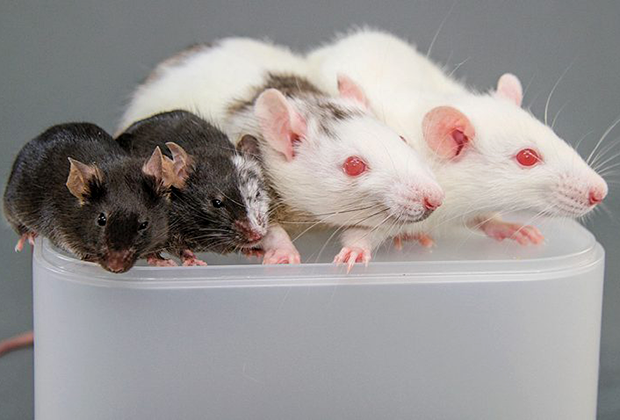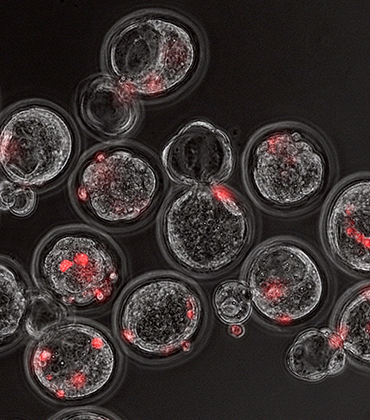
August 4, 2016 the United States National Institutes of Health (NIH) have declared that they intend to lift the moratorium on the creation of chimeras. This is a controversial ethically experiments in which human stem cells were injected into animal embryos - resulting shaped organisms that combine human and animal features. Scientists call them chimeras.
In ancient Greece, called chimeras mythological monster with the head and neck of a lion, body of a goat and the tail of a snake. The same chimeras are organisms with genetically dissimilar materials. They could serve as a convenient biological models for the study of a variety of diseases - such as cancer or neurodegenerative syndromes could be a source of organs for transplantation. However, it is experimental biology to come close to science fiction, the public fear that it could lead to unintended consequences.
When creating chimeras using stem cells with pluripotent. In other words, they are able to develop into all cells of the human embryo. Cells embedded in the fetal tissue model organisms (mice, rats, monkeys, pigs and other animals) at very early stages, and then allow the embryo to develop. In September 2015 NIH have expressed concern that if the stem cells will be put into the brains of mice, the result may turn out rodents with altered cognitive abilities - that is, will be allowed to "superintelligence". Therefore, the NIH, which awarded grants for biomedical research, decide to suspend funding experiments with chimeras, as their experts do not examine the ethical question.
Nevertheless, some research
groups in the United States already being engaged in the creation of chimeras. MIT Technology Review reports that in 2015 it was taken about 20 attempts to produce chimeras pig and sheep-man-man. Unfortunately, no scientific work has not yet been published, but it was not successful receipt of animals with human tissues messages.

From left to right: normal mouse, a mouse with a rat cell, a rat with mouse cells, normal rat.
Experiments with chimeric organisms as a combined genetic engineering and stem cell biology. Not easy to implement in an animal pluripotent embryo cells, because in this case the body can turn with catastrophic developmental disorders. Scientists typically "turn off" the genes in embryos so that they can not form a specific tissue. In this case, the stem cells take on the task of building the missing body, which is no different from the human, which makes it suitable for transplantation.
According to cardiologist Gerry Daniel (Daniel Garry), the first test of this method have been carried out in his laboratory. Researchers designed pigs that lacked some skeletal muscle and blood vessels. Such animals would be viable, however, researchers added embryo stem cells from other pig embryo. The results so impressed the US armed forces, provided that they Garry grant $ 1.4 million to the cultivation of the human heart in pigs. The scientist was going to continue his studies, despite a moratorium on the NIH, and was one of 11 authors who published a letter criticizing the decision biomedical center.
Scientists said that the moratorium introduced by the NIH, is a threat to the development of stem cell biology, developmental biology and regenerative medicine, and expressed doubt that with the help of stem cells is possible to obtain "humanized" animals with high intelligence. In particular, they pointed out that in the field of xenotransplantation experiments in which the nerve cells of people embedded in the brain of mice did not produce too clever rodents.

Human stem cells (red) in mouse embryos at the blastocyst stage.
As a precaution, some researchers are working on the creation of chimeras, did not allow his creatures to be born. Embryologists studying the embryos in order to obtain information about how large the contribution of human stem cells in fetal development. Nevertheless, despite the fact that some laboratory reinsured, chimeric animals already exist - for example, mouse, endowed with the human immune system. Such animals are created through the introduction of liver and thymus cells from aborted human fetuses into the body already born rodents.
Of greatest interest to scientists is the creation of chimeras at the blastocyst stage, when the fruit is a sphere consisting of a few dozen cells. This method is called complementation embryos (embryo complementation). In 2010, researchers in Japan have managed to create mice, the pancreas which consisted entirely of rat cells. Hiromitsu Nakauchi (Hiromitsu Nakauchi), lead author of the work, and later decided to create a "pig-human", for which he had to move to the United States as Japan's scientific committees do not approve of such experiments. Now a scientist working at Stanford University on a grant from the California Institute for Regenerative Medicine. According to him, most of the pluripotent cells introduced into embryos in his laboratory, made from his own blood, as bureaucratic barriers preventing recruitment by volunteers.
Most people hear the word "Chimera" are monsters created by mad scientists. Scientists will have to prove that human cells can actually multiply and form a complete and healthy organs in animals. Mice and rats are genetically quite similar, so the creation of chimeras in this case is not a problem. In the case of humans and pigs, a common ancestor that lived 90 million years ago, things could be different.
Scientists have already checked the pig embryo complementation human stem cells, but research began only after the approval of the three commissions on bioethics. Stanford University, which conducted the study, limited time of 28 days embryos (piglets born to 114 days). Nevertheless, the fruit will be sufficiently developed to be able to determine how the beginnings of organs are formed correctly.
Last week, the NIH proposed to replace the moratorium further examination to be undertaken by a committee composed of ethicists and experts in animal welfare. They will take into account such factors as the type of human cells, the place of their location in the embryo, as well as possible changes in the behavior and appearance of the animal form. The experts' conclusions will help NIH to decide whether to finance the project considered.
Pretty creepy stuff. I always feel bad for the mice and rats they test on, growing ears on their backs and stuff. Rats are such intelligent little creatures.
Downvoting a post can decrease pending rewards and make it less visible. Common reasons:
Submit
This article reminded me of the movie 'Splice'. If these experiments are legalized then I hope for them to not go bad as shown in that movie.
Downvoting a post can decrease pending rewards and make it less visible. Common reasons:
Submit
hi just a reminder if you have done research and have written about it just remember to provide a link source https://www.technologyreview.com/s/545106/human-animal-chimeras-are-gestating-on-us-research-farms/
Downvoting a post can decrease pending rewards and make it less visible. Common reasons:
Submit